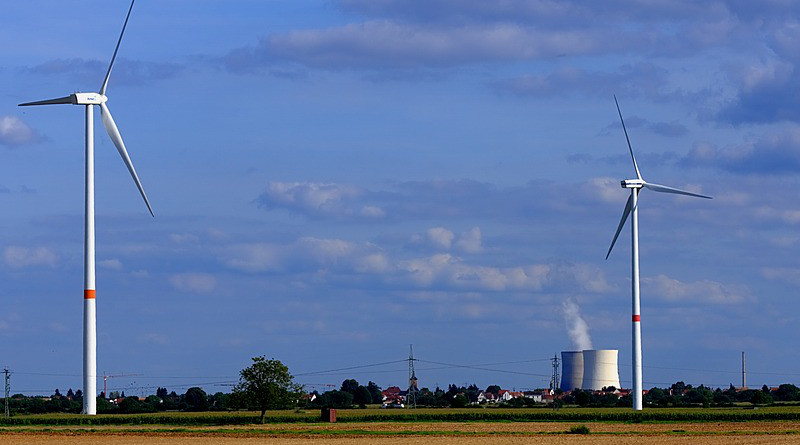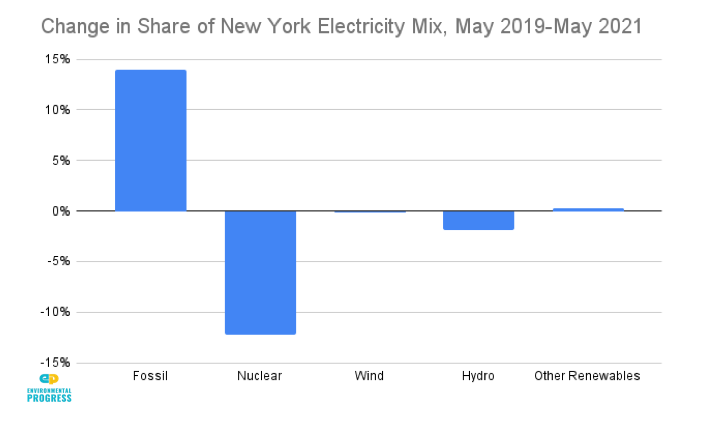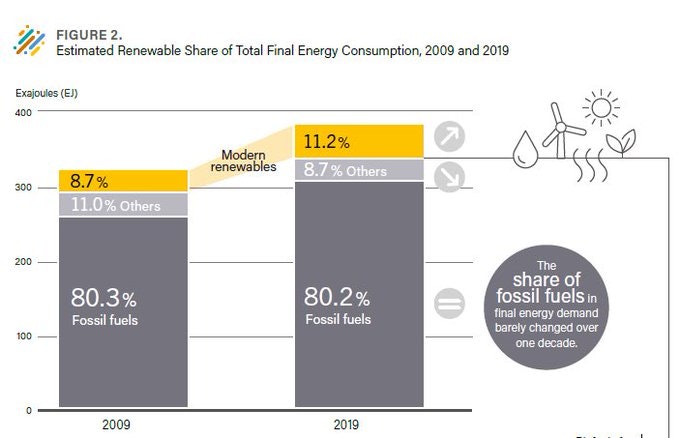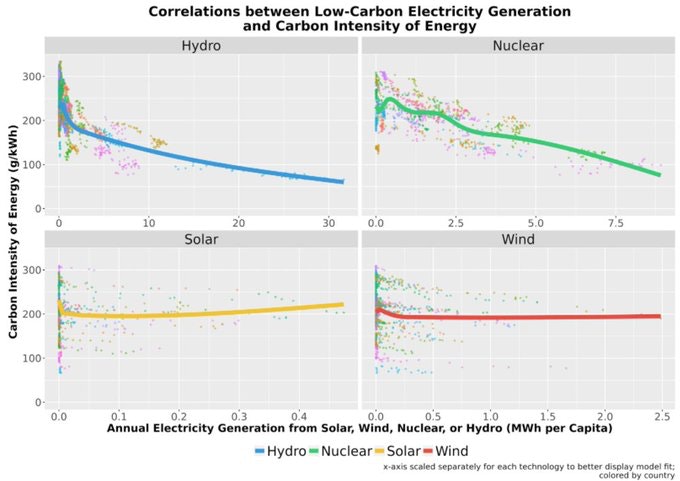Finally, They Admit Renewables Don’t Replace Fossil Fuels – OpEd
Bhaskar Sunkara is the founding editor of Jacobin, a socialist magazine, and author of The Socialist Manifesto: The Case for Radical Politics in an Era of Extreme Inequality. He is also an unlikely advocate for nuclear energy.
In a new article for The Guardian, Sunkara draws on Environmental Progress research which found that, in its first full month without Indian Point nuclear power plant, New York’s carbon emissions from in-state electricity generation rose 35 percent over the state’s pre-covid shutdown levels.
The same analysis found that the carbon intensity of New York’s electricity, the amount of carbon dioxide emissions per unit of electricity, rose 46 percent. And the share of electricity from renewables, including hydroelectric dams, actually declined between 2019 and 2021.
Sunkara’s article comes at a time when a growing number of progressives, socialists, and Democrats are speaking out for nuclear power. A few weeks ago, Emmet Penney, a founding member of Santa Fe’s Democratic Socialists of America (DSA) chapter, noted that “Nuclear plants bring wealth and meaning to their host communities” and, in a turn of phrase that elicited strongly positive responses from readers, Penney added, “They are American industrial cathedrals.”
Part of the reason for growing progressive support for nuclear is because of the research and advocacy of pro-nuclear organizations including Environmental Progress, which has forced renewable energy advocates, and now the industry itself, to admit that solar panels and wind turbines do not substitute for fossil fuels.
A new global study by a new renewable energy industry coalition finds that, over the last decade, the share of energy from fossil fuels was nearly unchanged, going from 80.3% to 80.2%. The reason is because, as my colleagues and I have documented over the last five years, unreliable, weather-dependent energies can’t replace reliable energies.
EP’s has done ground-breaking research on decarbonization since our founding in 2016. Environmental Progress in 2017 found that there was no correlation between solar or wind and the “carbon intensity” of energy — CO2 emissions per unit of energy — at an aggregated level.
By contrast, the deployment of nuclear plants and hydro-electric dams was strongly correlated with declining carbon intensity of energy. Why? Because both are reliable, and can thus replace coal and nat gas plants, where solar panels and wind turbines cannot. They can only operate alongside fossil fuels.
One year later, in 2018, Environmental Progress found that California and Germany could have mostly or completely decarbonized their electricity sectors had their investments in renewables been used for new nuclear instead.
“Environmental Progress,” wrote New York Times columnist Eduardo Porter, “estimated what California’s power sector would look like had the opposition from antinuclear forces — including Governor Jerry Brown — not undone the state’s deployment of nuclear energy, starting in the 1970s.”
Noted Porter, “The power from San Onofre and the Rancho Seco nuclear generation station near Sacramento, both now shuttered, added to that from the never-built Sundesert nuclear plant in the Mojave Desert and three planned-but-not-built units at Diablo Canyon on the state’s central coast, would add a total of 77,000 gigawatt-hours of zero-carbon power to California’s supply.
“Only 27 percent of the power produced in California would come from fossil sources, other things remaining equal, as opposed to 66 percent today. And carbon emissions from power generation would be only 40 percent of what they are today.”
And, as I told the United States Senate a few weeks ago, adding weather-dependent solar and wind to electrical grids diverted money away from reliable energy sources, namely nuclear and natural gas plants, which could have prevented the deadly and costly blackouts in California and Texas.
Environmental groups including the Sierra Club and Natural Resources Defense Fund (NRDC), the most influential environmental groups among Democrats, know this, of course, as do the fossil fuel companies they take money from, or invest directly in.
In our articles and our best-selling book, Apocalypse Never, soon to be in 17 languages, my colleagues and I have documented how the world’s most influential environmental NGOs work as front groups for fossil fuel interests. NRDC has roughly $70 million directly invested in oil and gas and renewable energy companies that stand to profit from the closure of nuclear plants.
Meanwhile, the five largest publicly-traded oil and gas companies — ExxonMobil, Royal Dutch Shell, Chevron, BP, and Total — have invested one billion dollars into advertising and lobbying for renewables and climate policy, as I first reported in 2019.
Sometimes, after I point these things out, someone will quip, “A lesson in unintended consequences.” But after 50 years of closing nuclear plants and promoting renewables, the main consequence of anti-nuclear advocacy — more fossil fuel pollution — can not be considered unintentional.
Some pro-nuclear progressives criticize Environmental Progress and me for pointing out the limitations of renewables, including their role in increasing emissions. They have insisted that, by not talking about the problems with solar panels and wind turbines, progressive pro-nuclear advocates could build a coalition with renewable energy advocates.
But it hasn’t worked that way. Despite strenuous efforts by pro-nuclear progressives to curry favor with Environmental Defense Fund, NRDC, and Sierra Club, for well over ten years, all three organizations are, at this moment, lobbying to close nuclear plants in Illinois and California.
Pro-nuclear advocates haven’t even won support from anti-nuclear environmentalists for futuristic nuclear plants, like the miniature reactor Bill Gates says he wants to build in Wyoming, or micro-reactors so small that they couldn’t provide electricity for rich nations like the U.S.
Rather, what has worked to save nuclear power plants, and change public opinion, has been seeking and telling the truth, as EP has done since its founding in 2016. As progressives have been educated about the physics of energy, the corruption of EDF, NRDC, and Sierra Club, and the Malthusian motivations of environmentalists, their support for nuclear power has grown.
“My commitment to the left came to its final breaking point,” wrote Emmet Penney, after “Governor Cuomo and environmental groups like the Riverkeeper and the Natural Resource Defense Council forced the premature closure of Indian Point nuclear plant.”
Back in 2016, I knew support for nuclear would grow by standing up for the truth because, as a progressive anti-nuclear advocate for renewables, it was what led me to change my mind. Steven Pinker, Richard Rhodes, Stewart Brand, and other progressives spoke out for the technology against a strong taboo against the technology on the Left. Their courage, compassion, and intelligence changed my mind, and led me to speak out, too.
Our work has paid off. Notes socialist activist Sunkara, “Americans’ support for constructing new plants is now at 50%, markedly higher than in years past,” he writes. “On the political left, in particular, where opposition to nuclear first catalyzed decades ago, there seems to be a shift underway.”




